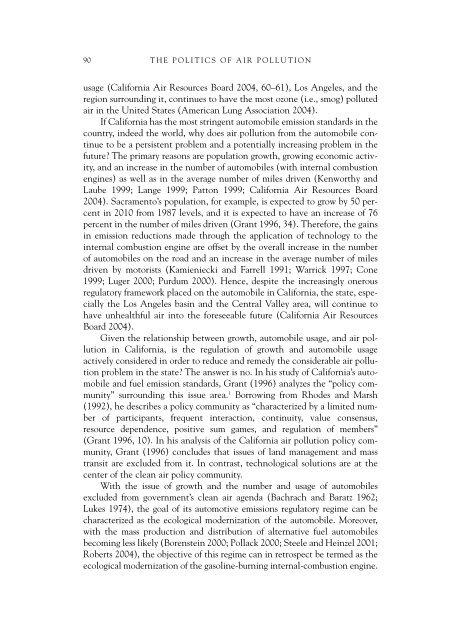GEORGE A. GONZALEZ - fieldi
GEORGE A. GONZALEZ - fieldi
GEORGE A. GONZALEZ - fieldi
You also want an ePaper? Increase the reach of your titles
YUMPU automatically turns print PDFs into web optimized ePapers that Google loves.
90THE POLITICS OF AIR POLLUTIONusage (California Air Resources Board 2004, 60–61), Los Angeles, and theregion surrounding it, continues to have the most ozone (i.e., smog) pollutedair in the United States (American Lung Association 2004).If California has the most stringent automobile emission standards in thecountry, indeed the world, why does air pollution from the automobile continueto be a persistent problem and a potentially increasing problem in thefuture? The primary reasons are population growth, growing economic activity,and an increase in the number of automobiles (with internal combustionengines) as well as in the average number of miles driven (Kenworthy andLaube 1999; Lange 1999; Patton 1999; California Air Resources Board2004). Sacramento’s population, for example, is expected to grow by 50 percentin 2010 from 1987 levels, and it is expected to have an increase of 76percent in the number of miles driven (Grant 1996, 34). Therefore, the gainsin emission reductions made through the application of technology to theinternal combustion engine are offset by the overall increase in the numberof automobiles on the road and an increase in the average number of milesdriven by motorists (Kamieniecki and Farrell 1991; Warrick 1997; Cone1999; Luger 2000; Purdum 2000). Hence, despite the increasingly onerousregulatory framework placed on the automobile in California, the state, especiallythe Los Angeles basin and the Central Valley area, will continue tohave unhealthful air into the foreseeable future (California Air ResourcesBoard 2004).Given the relationship between growth, automobile usage, and air pollutionin California, is the regulation of growth and automobile usageactively considered in order to reduce and remedy the considerable air pollutionproblem in the state? The answer is no. In his study of California’s automobileand fuel emission standards, Grant (1996) analyzes the “policy community”surrounding this issue area. 1 Borrowing from Rhodes and Marsh(1992), he describes a policy community as “characterized by a limited numberof participants, frequent interaction, continuity, value consensus,resource dependence, positive sum games, and regulation of members”(Grant 1996, 10). In his analysis of the California air pollution policy community,Grant (1996) concludes that issues of land management and masstransit are excluded from it. In contrast, technological solutions are at thecenter of the clean air policy community.With the issue of growth and the number and usage of automobilesexcluded from government’s clean air agenda (Bachrach and Baratz 1962;Lukes 1974), the goal of its automotive emissions regulatory regime can becharacterized as the ecological modernization of the automobile. Moreover,with the mass production and distribution of alternative fuel automobilesbecoming less likely (Borenstein 2000; Pollack 2000; Steele and Heinzel 2001;Roberts 2004), the objective of this regime can in retrospect be termed as theecological modernization of the gasoline-burning internal-combustion engine.









